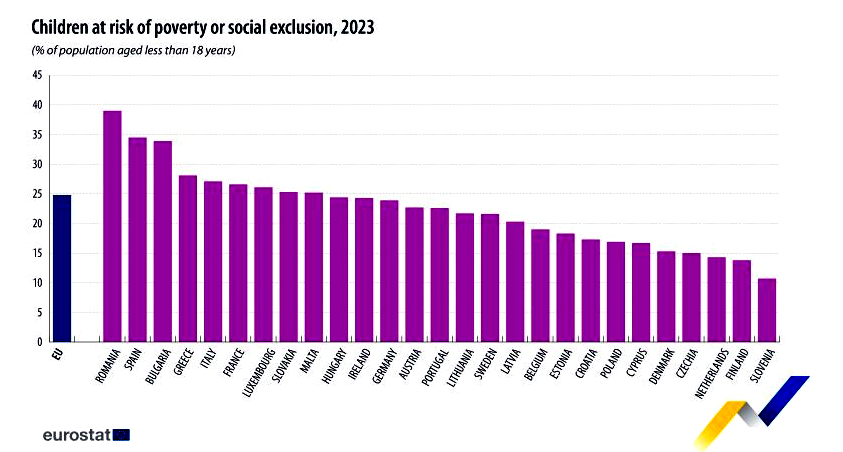
This article presents statistical data on the situation of children (aged less than 18 years) in the European Union (EU) who were at risk of poverty or social exclusion (AROPE) in 2023.
In 2023, 24.8 % of children (aged less than 18 years) in the EU were at risk of poverty or social exclusion, compared to 20.6 % of adults (aged 18 years and over).
In 2023, the proportion of children at risk of poverty or social exclusion in the EU was 24.8 %. At national level, the highest rates were observed in Romania (39.0 %), Spain (34.5 %) and Bulgaria (33.9 %). On the other side, the lowest rates were recorded in Slovenia (10.7 %), Finland (13.8 %) and the Netherlands (14.3 %).
The percentage of children at risk of poverty or social exclusion remained relatively stable between 2022 and 2023
At the EU level, between 2022 and 2023, the percentage of children at risk of poverty or social exclusion went from 24.7 % to 24.8 %.
At the national level, Hungary recorded the largest rise, up by 6.3 percentage points (pp), followed by Spain (+2.3 pp), and both Luxembourg and Malta (+2.1 pp each). In contrast, decreases were observed in Romania (-2.5 pp), Cyprus and Italy (both -1.4 pp), and Finland (-1.1 pp). Bulgaria and Greece reported stable figures.
In 2023, 61.8 % of children in the EU living with parents who had at most lower secondary education (ISCED levels 0-2) were at risk of poverty or social exclusion. For those with parents who attained tertiary education (ISCED levels 5-8), the proportion was 10.7 %. This resulted in a risk gap of 51.1 percentage points (pp) based on parents' education levels.
At the national level, the gap was above 50.0 pp in 15 countries. It ranged from 21.9 pp in Poland, 35.8 pp in Malta and 36.6 pp in Lithuania to 72.5 pp in Hungary, 73.5 pp in Romania and 74.9 pp in Bulgaria.
The data used in this article are derived from the EU Statistics on income and living conditions (EU-SILC). EU-SILC data are compiled annually and are the main source of statistics that measure income and living conditions in Europe; it is also the main source of information used to link different aspects relating to the quality of life of households and individuals.

read more in our Telegram-channel https://t.me/The_International_Affairs

 10:09 28.07.2024 •
10:09 28.07.2024 •






















